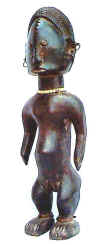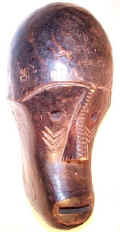 |
 |
TRIBAL AFRICAN ART
NGBANDI (GBANDI, MOGWANDI, MONGWANDI)
Democratic Republic of the Congo and Central African Republic
Located
on the left bank of the Ubangi River, the 120,000 Ngbandi have lived in this area of
forest and plains since the 17th century. Their settlements were dispersed and lack
of overall political organization; a hamlet would generally be made up of an extended
family or patrilineal clan. They practiced slash-and-burn agriculture growing manioc,
maize, sorghum and bananas and lived off fishing and hunting. The Ngbandi had a
system of initiation named gaza or ganza: “that which gives
strength.” Future initiates had to undergo trials of physical endurance and would
attain a first level of knowledge by means of song and corporeal techniques, particularly
choreographic turns. In the rites of passage, re-creations of ancestors played an
important role. Circumcision and excision took place after several months spent outside
the village.
Artistic products include figures, masks, pipes, necklaces, sticks, musical instruments, and zoomorphic statuettes used in the hunt. Large slit drums are common. The artistic style of their statues and masks, which are closely related to Ngbaka, is characterized by the elongated features and a line of vertical scarification on the nose, forehead and sometimes in the sides. The statues have rather slim bodies; arms usually against the torso but occasionally separated; legs slightly apart; hair indicated by triangular incisions. The masks have flat, oval eyes with white paint around them, making the masks rather stylized. Most of the statues and masks were used by the bendo (diviner) in magical ceremonies, although some ancestor-cult statues are also known. Figures representing Ngbirondo spirit are kept in special huts where libations are poured over them. They can also be placed at the entrance to the village for apotropaic reasons. Some masks have simian features; their function during initiation is not known.